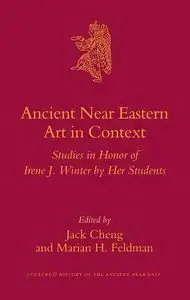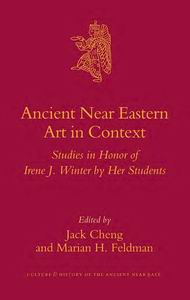Ancient Near Eastern Art in Context (Culture and History of the Ancient Near East) By Feldman, M. Cheng, J.
Publisher: BRILL 2007 | 522 Pages | ISBN: 9004157026 | PDF | 6.1 MB
Publisher: BRILL 2007 | 522 Pages | ISBN: 9004157026 | PDF | 6.1 MB
Through published works and in the classroom, Irene Winter served as a mentor for the latest generation of scholars of Mesopotamian visual culture. The contributions to this volume in her honor represent a cross section of the state of scholarship today.
INTRODUCTION
Jack Cheng and Marian H. Feldman
Irene Winter is widely recognized as the seminal scholar of ancient
Near Eastern art of her generation, in large part due to the limitless
imagination of her scholarship and her insistence on the material’s
relevance in art historical and Mesopotamian studies. She began her
career with a magisterial dissertation on North Syrian ivories that
immediately established her commitment to an understanding of Near
Eastern art through a contextualizing lens. She subsequently turned
her attention to Neo-Assyrian arts and in particular the throneroom
of Ashurnasirpal II at Nimrud. Building on the work of Julian Reade,
Mario Liverani and others, Irene broke fresh ground in proposing
the expression of a coherent Assyrian ideological system by means of
a programmatic architectural, visual and textual design. Similarly, in
her work on Gudea of Lagash, she brought text and image together
and forged them through her familiarity with ethnography to reframe
a study of statuary into a consideration of living idols that required
care and maintenance. Again and again, objects that seem to have exhausted
their store of historical information become not deconstructed
but re-constructed under Irene’s gaze, opening up new possibilities
for understanding them. Fully engaged in the Near Eastern sources
while drawing upon theoretical approaches from numerous disciplines
rarely brought together, Irene arrives at conclusions that had never
before been considered and that irrevocably alter the way we see
the artifacts under study. In addition, she has taken care to publish
her papers in a range of journals and essay collections so that the
material reaches the greatest audience and so that discussions of the
theories and ideas presented enter a diversity of fields and disciplines
where they may be further tested and applied.
At the same time, Irene has always taken her pedagogical responsibilities
seriously and has shared her teaching across a wide spectrum of
eager acolytes. For that reason, when several of her students considered
what form of tribute would be fitting for her, they decided that a
volume of essays, written and edited by the younger generation that
has benefited so much from her intellectual generosity, was particularly
apt. Thus was born this collection of essays that is uniquely informed
by the perspective of our educational formation under her tutelage.
Toward the end of January 2006, Irene and Jack spoke about the
recent passing of Erica Reiner and Hayim Tadmor. “Those were the
last two who had any connection to my dissertation,” she told him.
“It’s a little like losing your last parent.” And then, of course, Irene
told more stories of her mentors, never flinching from telling details
even if they were unflattering—to them or to herself—and always
conveying the mutual warmth and respect she felt for her friends.
It’s a shame, Jack responded, that this rich history “behind the
scenes” in Near Eastern scholarship is never preserved. Oh, but it
is, Irene said. “I’ve heard so many stories from [Edith] Porada and
Leo [Oppenheim] and I tell them to you, and you’ll pass down those
stories, and maybe stories about me. They may not last more than
three generations, but they’re there.”
We had considered writing down some of these stories, but upon
reflection the stories serve better in an oral tradition for a number of
reasons. Libel laws being the first. But also because in an oral tradition
the stories take on the sheen of legend or fable, and become
more meaningful for that reason. One story we love to hear Irene
tell involves two of her mentors, Edith Porada and Leo Oppenheim.
The bare bones version: Edith, while studying in a Chicago library,
was coaxed out for a ride in Oppenheim’s red convertible and even
escaped the library from a second story window. We’re sure we’ve
gotten more than one detail wrong in the retelling but it doesn’t
matter—it’s a great story because of the wonderful image and because
it reveals that the professor emeritus we knew at Columbia University
was once vivacious and impetuous; for all her dedication to her work,
even Porada knew there was more to life than the library.
Stories about Irene are not like that. They don’t reveal a side of
her that you didn’t know because those sides aren’t there. Her public
conduct is as warm, generous, open and principled as her private life.
And in turn, she socializes, follows horse racing and reads science fiction
novels with the same enthusiasm and intensity that she brings to
her scholarship. One doesn’t wonder what Irene “really” feels about
art collectors, or a particular museum curator, or her students. In her
teaching, her lectures and her writing she makes her positions clear.





